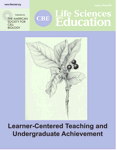Integration of Information and Scientific Literacy: Promoting Literacy in Undergraduates
Abstract
The Association of College and Research Libraries recommends incorporating information literacy (IL) skills across university and college curricula, for the goal of developing information literate graduates. Congruent with this goal, the Departments of Biological Sciences and Information Science developed an integrated IL and scientific literacy (SL) exercise for use in a first-year biology course. Students were provided the opportunity to access, retrieve, analyze, and evaluate primary scientific literature. By the completion of this project, student responses improved concerning knowledge and relevance of IL and SL skills. This project exposes students to IL and SL early in their undergraduate experience, preparing them for future academic advancement.
INTRODUCTION
The National Research Council [NRC] challenges faculty to provide authentic learning opportunities to first-year biology students (NRC, 2003). To explore science as a process, students need to be information literate; that is, they must be able to locate, retrieve, evaluate, and effectively use information, while using appropriate technologies (Warnken, 2004; Association of College and Research Libraries [ACRL], 2006; Mahaffy, 2006). Faculty and librarians (with support from the administration) must work collaboratively to provide appropriate pedagogical practices that will achieve these literacy goals (Hunt and Birks, 2004; Warnken, 2004; ACRL, 2006).
Related to a general ability to find and use information, scientific literacy (SL) describes an ability to understand, analyze, and evaluate scientific data while integrating these data into a greater body of scientific knowledge (NRC, 1996; Gillen, 2006). Developing information literacy (IL) and SL requires similar skills and cognitive abilities; integrating these literacies is both efficient and meaningful.
The ACRL describes ideal IL programs as those that include an emphasis on student-centered learning, are embedded in discipline-specific instruction, and foster collaboration among faculty and librarians (ACRL, 2003; Jacob and Heisel, 2008). In response to the ACRL guidelines (2003, 2006), faculty members from the Departments of Biological Sciences and Information Science at University of the Sciences in Philadelphia (USP) developed an integrated IL program (Scientific Method and Information Literacy Exercise: SMILE) within a general biology course; this program satisfies an information literacy skill as part of the General Education (Gen Ed) curriculum at USP (USP, 2009). SMILE is designed to challenge students to “think scientifically” (Alberts, 2005; Alberts, 2009), while building a foundation of IL skills that will prepare them for more advanced activities as they progress in their academic careers (e.g., capstone experience, undergraduate research, graduate research) (Kozeracki et al., 2006; Lopatto, 2007). By providing this integrated approach early in our students' higher education career, we are fostering the development of graduates literate in both scientific and information disciplines (Porter, 1992, 2005; Flaspohler et al., 2007).
Description of SMILE
SMILE is a learning-centered (Weimer, 2002; Blumberg, 2009) innovation implemented in the second semester of a two-semester general biology course. At the completion of SMILE students will 1) be able to distinguish primary from secondary scientific literature; 2) demonstrate an ability to analyze and evaluate data in a primary, scientific article; 3) critique the research protocol used by the authors or describe a research protocol to extend the research described in the paper; 4) use IL skills to access, retrieve, and cite scientific literature; and 5) reflect upon the relevance of IL and SL skills to their academic career.
Students select, retrieve, read, analyze, and evaluate an article from the journal Animal Behaviour to build IL and SL skills. This journal was selected because it contains articles that demonstrate the scientific method that are accessible to students at the beginning stages of their higher education career. SMILE addresses ACRL IL standards that relate to effectively accessing and evaluating information, as well as correctly and ethically citing sources (ACRL, 2006). SMILE also requires a student's careful analysis and evaluation of one (in 2009) or two (in 2008) quantitative figure(s). Students use their understanding of the data in a figure to further develop a research hypothesis and experimental design. This experience gives students the opportunity to develop their IL and SL skills for interpretation and extrapolation of data within a primary research article.
Relevance of SMILE to Developing Critical Thinking and Information Literacy Skills in Diverse Student Populations
SMILE fulfills an IL requirement within our Gen Ed curriculum. The Gen Ed philosophy at USP is that “educated persons attain a broad understanding of the human experience through exposure to diverse ideas, perspectives, and modes of thinking …” (USP, 2009). Gen Ed is a developmental process that provides intellectual growth for our students. In keeping with this philosophy, SMILE facilitates the development of critical, nonlinear thinking and information literacy skills, serving as a foundation for students at USP. Therefore, we believe SMILE can provide opportunities to develop IL and SL skills of undergraduates regardless of their area of study.
IL and SL Skill Development within SMILE
The first semester of general biology is steeped in scientific literacy skills, such as science as a nonlinear process, the scientific method, experimental design, and interpretation of data. Because of this previous experience, we require students to use all six cognitive process dimensions (“remember” through “create”) to complete the SL portion of SMILE (Figure 1) (Anderson et al., 2001). In contrast, SMILE typically provides the first opportunity (at USP) that students have to learn IL skills in the context of primary scientific literature. The IL skills that students have an opportunity to develop within SMILE are accessing and retrieving primary and secondary literature from online databases, providing complete and accurate citations, as well as using information in an ethical manner. Therefore, IL skills needed to complete SMILE are at the lower cognitive process dimensions of “remember” and “understand” (Figure 1; Anderson et al., 2001).
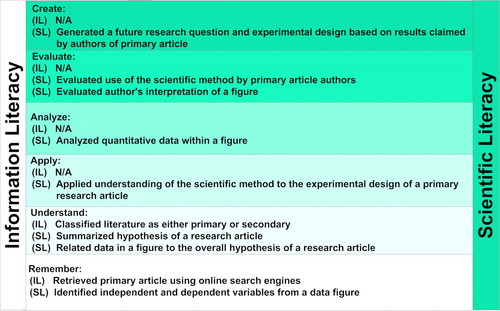
Figure 1. Representation of how various SL and IL skills involved in the completion of SMILE relate to the six cognitive process dimensions according to Anderson et al. (2001).
MATERIALS AND METHODS
Description of Student Demographics
This innovation was implemented for two different cohorts of students (2008: n = 372; 2009: n = 405). Primarily first-year students were enrolled in the course (2008: 90% first-year, 10% second-year; 2009: 89% first-year, 11% second year), and all of the students enrolled in the course are in either science or health-science majors at USP. Fifty-nine to sixty-three percent of the 2008 and 2009 cohorts are female, which is representative of the student body at USP (Table 1).
| Program enrolled (expected degree) | 2008 | 2009 | ||
|---|---|---|---|---|
| Femalea | Malea | Femalea | Malea | |
| Chemistry (BS) | 0 (0) | 1 (<1) | 1 (<1) | 0 (0) |
| Pharmaceutical Chemistry (BS) | 0 (0) | 0 (0) | 1 (<1) | 1 (<1) |
| Humanities and Science (BS) | 1 (<1) | 0 (0) | 0 (0) | 1 (<1) |
| Pharmaceutical Marketing and Management (BS) | 8 (4) | 8 (5) | 9 (4) | 4 (3) |
| Pharmaceutical Sciences (BS) | 7 (3) | 2 (1) | 13 (5) | 4 (3) |
| Pharmacology and Toxicology (BS) | 6 (3) | 6 (4) | 9 (4) | 5 (3) |
| Psychology (BS) | 2 (<1) | 2 (1) | 5 (2) | 3 (1) |
| Health Sciences (BSHS) | 1 (<1) | 0 (0) | 1 (<1) | 1 (<1) |
| Fitness and Health Management (BS) | 1 (<1) | 0 (0) | 0 (0) | 0 (0) |
| Physician Assistant Studies (BSHS) | 14 (6) | 2 (1) | 11 (4) | 3 (2) |
| Pharmacy (PharmD) | 150 (68) | 113 (74) | 159 (62) | 114 (79) |
| Physical Therapy (DPT) | 19 (9) | 16 (10) | 31 (12) | 10 (7) |
| Occupational Therapy (MOT) | 8 (4) | 2 (1) | 7 (3) | 2 (1) |
| Undeclared | 2 (<1) | 1 (<1) | 8 (3) | 2 (1) |
| Total | 219 | 153 | 255 | 150 |
Implementation of SMILE
SMILE has multiple steps that occur over a five-week period at the beginning of the spring semester (Table 2; Figure 2). Students are asked to complete a pretest to assess perceived relevance and knowledge of IL and SL skills before SMILE is assigned. Students then attend two 1-hr workshops (Table 2). The first of these, taught by a member of the Information Science Department, introduces IL concepts: how to paraphrase while avoiding plagiarism, how to use online databases to access and retrieve primary and secondary literature, and why information literacy skills are necessary to access scientific thought. The second workshop, taught by members of the Department of Biological Sciences, is a modeling session on how to effectively complete SMILE. Students are introduced to an Animal Behaviour article (i.e., Roulin and Bersier, 2007) that serves as the model paper for this exercise. The biology instructors use the model to demonstrate appropriate answers to all SMILE questions during this workshop. Students have access to the model paper and a model completed project through the online course management software Angel. Modeling the appropriate completion of a complex assignment allows for the desired transfer of skills to the students (Firooznia and Andreadis, 2007; Jacob and Heisel, 2008). Our modeling sessions and access to a model project clarify the instructors' expectations for successful completion of SMILE.
| Week | Activity | Formata | Facilitatorb |
|---|---|---|---|
| 1 | Introduction to SMILE | In-class/online (Angel) | BF |
| 2 | Completion of pretest | Online (Angel) | BF |
| 3 | IL training | In-class | ISF |
| Modeling SMILE | In-class | BF | |
| SMILE assigned to students | Online (Angel) | BF | |
| 4 | Angel support | Online/in-class/office meetings | ISF/BF |
| SMILE support | Online/email/office meetings | ISF/BF | |
| 5 | SMILE and posttest due | Online (Angel) | BF |
| 6–12 | Grading SMILE | Online (Angel) | BF |
| 13 | Feedback and grade to students | Online (Angel)/office meetings | BF |
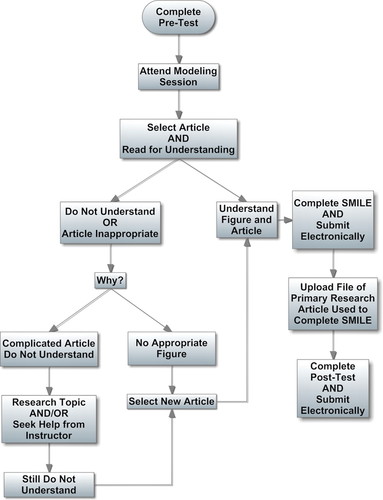
Figure 2. Schematic of the decision process students must complete to select an appropriate primary journal article along with the tasks that must be accomplished to successfully complete SMILE.
At the end of these workshops, students are assigned a specific issue of Animal Behaviour. Students choose, retrieve (using appropriate databases available through the USP library), and carefully read a research article from this issue (Table 2; Figure 2). After the article is understood, students answer specific questions concerning how the article follows the scientific method, what the data in a chosen figure mean, how these data relate to the rest of the article, and what modifications or expansions could be made to the design of the experiment. The SMILE project and a file of the original primary article used to complete SMILE is then electronically submitted. After these submissions, each student completes a posttest (that is identical to the pretest). A comparison of the responses of students on the posttest to the pretest provides us with an analysis of the knowledge gained (at the “remember” and “understand” cognitive process dimensions; Figure 1) and an understanding of attitudinal changes due to completing the SMILE process.
RESULTS
Student Performance on SMILE
SMILE is designed to promote successful development of IL and SL skills. Therefore, it is not surprising that students achieved a mean of 87 ± 8% (mean ± SD; 2008) and 88 ± 10% (2009) for their final SMILE grades (Figure 3A). Likewise, within all objectives of SMILE, the mean of the percent grades was 80% or greater (Figure 3, B–E). These data suggest that at the completion of SMILE students are able to meet the learning objectives of this exercise.
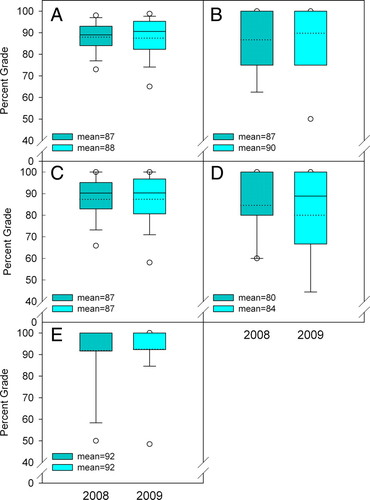
Figure 3. Comparison of percent grades students achieved for (A) the entire project, (B) identifying primary and secondary literature, (C) analyzing and evaluating data within a figure, (D) developing an experimental design, and (E) accessing and retrieving scientific literature (2008 and 2009). Box and Whisker plot: dotted lines are mean, solid lines are median, boxes are 25th and 75th percentiles, whiskers are 10th and 90th percentiles, and circles are 5th and 95th percentiles (missing circles indicate no points beyond the 10th or 90th percentiles).
Evidence for IL and SL Knowledge Gain
The comparison of the pre- and posttest results allowed for an assessment of any knowledge change, at the “remember” and “understand” cognitive process dimensions (Figure 1) that occurred through the completion of this project. We compared both students who changed their answers from the pre- to posttest (either from incorrect to correct or from correct to incorrect; left side Figure 4A) and those who did not change their answer (either correct or incorrect; right side Figure 4A). Only 8 ± 1% (mean ± range; right side Figure 4A, C/I category) changed their answer to an incorrect response for the definition of a secondary article. Significantly more students, 43 ± 5% (left side Figure 4A, I/C category), changed their answer to a correct response (McNemar's Test, χ2 = 81.34, df = 1, P < 0.001). When combined with those students who did not change their correct answer from pre- to posttest (36 ± 3%; right side Figure 4A, C/C category), 78% of students correctly identified the definition of a secondary article following the completion of SMILE. Given that 90 ± 3% (2008 and 2009) of students properly identified the definition of a primary article on both the pre- and posttest (data not shown), we conclude that the majority of students are able to distinguish between the definitions of primary and secondary literature after SMILE; students are achieving the first learning objective of SMILE (ability to distinguish between primary and secondary scientific literature; see Description of SMILE above).
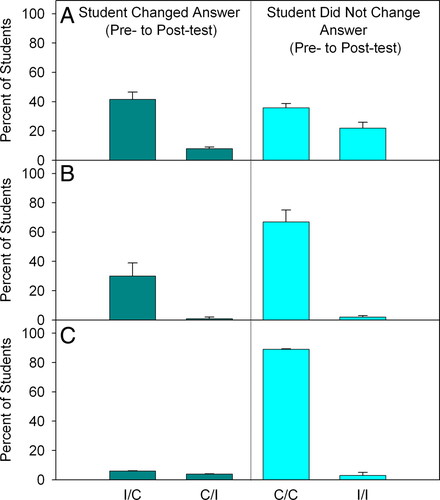
Figure 4. Comparison of the percentage of students who changed their answer from the pretest to the posttest (left side) versus students who did not change their answer (right side). Knowledge questions related to proper identification of (A) a secondary article, (B) a figure as a graphical representation of data, and (C) the scientific method as a nonlinear process for testing hypotheses. Bars are average of 2008 and 2009 data ± range. I/C = incorrect pretest response, correct posttest response; C/I = correct pretest response, incorrect posttest response; C/C = correct pretest response, correct posttest response; I/I = incorrect pretest response, incorrect posttest response.
When asked to identify the definition of a figure significantly more students (30 ± 9%) corrected their answer on the posttest as compared with those who changed their answer incorrectly (McNemar's Test, χ2 = 95.72, df = 1, P < 0.001) (left side; Figure 4B). Therefore, 97 ± 17% of students were able to identify a figure as a graphical representation of data (at the “remember” cognitive process dimension) by the completion of SMILE (combined I/C and CC; Figure 4B). Students were immersed in a year-long discussion (General Biology I and II) of the scientific method and its appropriate use; it is not surprising that students recognized the function of a figure. Success with these foundational skills allows for further development through a student's academic career.
Given students' previous experience with SL skills, it is not surprising that 89 ± 0.3% (2008 and 2009) were able to correctly identify the scientific method as a process for testing hypotheses on the pre- and posttest (Figure 4 C). There was no significant difference between students who changed their answers to correct or incorrect from the pre- to posttest (McNemar's Test, χ2 = 0.658, df = 1, P = 0.412; Figure 4C). The initial high level of correct response may reflect a pre-/posttest question that was too simplistic, the inherent strength of our health science students, and/or the retention of knowledge gained from the first semester of this general biology course.
Relevance of IL and SL Skills
An analysis of attitudinal responses on the posttest compared with pretest reveals SMILE increased students' perception of relevance of IL and SL skills for meeting their academic career goals. Students were asked two questions: 1) how relevant to their future academic career is using online databases to access primary literature (Figure 5A); and 2) how relevant to their future academic career is the analysis of published data (Figure 5B). In both cases, there was a significant change toward the Extremely and Very relevant responses after completing SMILE (access primary literature: Wilcoxon Signed Rank Test, W+ = 29341.5, df = 728, P < 0.001; analysis of data: Wilcoxon Signed Rank Test, W+ = 32495.0, df = 728, P < 0.001). In contrast, when asked about the relevance of understanding the scientific method (Figure 5C), there was no significant change from pre- to posttest (Wilcoxon Signed Rank Test, W+ = 39979.5, df = 728, P = 0.466). Students appeared to be convinced of the relevance of the scientific method before SMILE, and this perception persisted after the completion of the project. These results suggest that opportunities to engage with IL and SL skills can have a strong positive impact on students' perceived relevance of retrieving and analyzing primary literature.
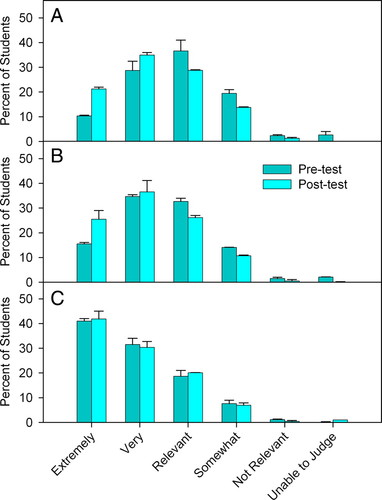
Figure 5. Students' perceived relevance of IL and SL skills to their academic career at USP for (A) using online databases to access primary literature, (B) analyzing published data, and (C) understanding the scientific method as a process. Bars are average of 2008 and 2009 data ± range. Likert Scale: Extremely Relevant, Very Relevant, Relevant, Somewhat Relevant, Not Relevant, or Unable to Judge.
DISCUSSION
To reach their maximum academic potential, science and health science students must have the opportunity to develop IL and SL skills early and progressively in their higher educational experience (Jerde and Taper, 2004; Denofrio et al., 2007). Students demonstrate increased knowledge of, and confidence with, IL and SL skills through symposia (Houde, 2000), presentations (Ferrer-Vinent and Carello, 2008), and journal clubs (Roberts, 2009). These findings highlight the importance of integrating IL and SL activities. In completing SMILE, students demonstrate their ability to use IL and SL skills to distinguish primary from secondary literature and to analyze and evaluate scientific data. Students report an increased perception of the relevance of accessing scientific literature and analyzing scientific data to their academic endeavors. Together these indicate that students who successfully complete SMILE achieve the learning objectives of this exercise. SMILE succeeds because it allows students to integrate IL and SL skills while they are exposed to science as a process of inquiry.
While the majority of students were successful with this particular project and did show the development of IL and SL skills, it is our contention that this single intervention, by itself, will not produce literate graduates. While an early exposure to IL and SL skills is important, equally important is the continued, progressive development of these skills across the curriculum. This development allows students to construct their own understanding of science as a process (McIntosh 2001) and to build their own framework for using and analyzing information. Members of the Information Science faculty at USP depend on SMILE for developing a foundation of IL competence, which is built upon throughout the students' academic careers culminating in a capstone experience. Faculty, librarians, and administrators must be committed to this progressive development to reach the goal of literate university and college graduates.
FOOTNOTES
This project (IRB%: 07-021) was reviewed by the University of the Sciences in Philadelphia Institutional Review Board and determined to be exempt.
Accessing Materials: SMILE, the pretest, the posttest, and instructions are available at www.usp.edu/SMILE free-of-charge to anyone who wishes to use them.
ACKNOWLEDGMENTS
P. Blumberg and K. Liebowitz assisted with pre- and posttest design, L. Pontiggia assisted with statistical analysis, and P. Blumberg, J.R. Porter, and M. Adams offered critical review of this manuscript. This innovation is supported by the Departments of Biological Sciences and Information Science and the Teaching and Learning Center at USP.


